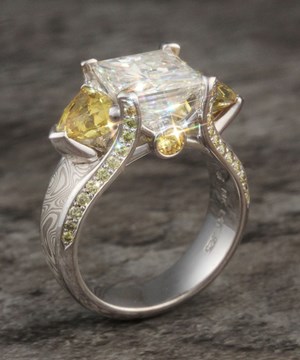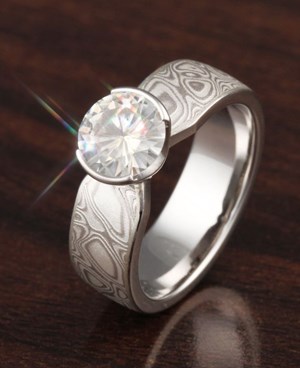Diamond Alternatives: Sparkling Moissanite Engagement Rings
The Best Diamond Alternative for Engagement Rings

 What Is Moissanite?
What Is Moissanite?
Moissanite is a unique gemstone, both synthetic and a diamond simulant. However, it’s not a synthetic diamond. As a diamond simulant, moissanite diamonds are crafted to resemble diamonds. Though lab-created, moissanite has a molecular structure like a naturally occurring stone, making it a standout choice for moissanite engagement rings.
The Difference Between a Diamond Simulant and a Synthetic Diamond
A diamond simulant mimics the look of a diamond but lacks a diamond's molecular structure. For instance, glass or cubic zirconia (CZ) can be cut to resemble diamonds but are not durable enough for moissanite diamond rings or engagement rings.
A synthetic diamond, however, is lab-created but retains the same molecular properties as a naturally formed diamond. It is essentially a real diamond created in a controlled environment.
Why Moissanite Diamonds are the Best Choice for a Diamond Alternative
Unlike other diamond alternatives, moissanite diamonds are exceptionally durable. With a hardness of 9.25, they come the closest to diamond’s 10 on the Mohs scale. Engagement moissanite rings are proven to withstand the test of time, whereas lesser simulants may lose their luster within a year of wear.
Moissanite also boasts an immense sparkle, making it very difficult for the untrained eye to distinguish it from a natural diamond. Additionally, being lab-grown, it’s an eco-friendly and ethical choice, making your moissanite diamond engagement ring a perfect option for a couple looking for more environmentally conscious options.
White Stone Comparison Chart
| Diamond | Moissanite | White Sapphire | Cubic Zirconia | |
| Hardness | 10 | 9.25 | 9 | 7.5 |
| Durability with Daily Wear |
Lifetime, very low likelihood of chips |
Lifetime, small chance of chipping |
Lifetime, will likely chip |
Up to a couple of years, surface will abraid quickly |
| Color | Varies; D-H appears olorless |
Three versions: Classic is K-M, Brilliant is H-J, One is colorless |
Usually colorless, can have pale tones of sapphire colors, such as blue or yellow |
Colorless |
| Origins | Natural or Lab Created |
Lab Created | Natural or Lab Created (colorless) |
Lab Created |
| Dispersion (fire) | Very dispersive, flashes of rainbow colors |
Extremely ispersive, flashes of rainbow colors |
No dispersion; flashes are only white |
Medium dispersion, some flashes of color |
| When dirty | Looks great even when dirty behind stone, still sparkles |
Looks great even when dirty behind stone, still sparkles |
Looks muddy and dull when dirty behind the stone (very unattractive when dirty) |
Looks dull when dirty behind the stone |

Moissanite: Brilliance and Fire
Moissanite diamonds exhibit unmatched brilliance due to their higher refractive index compared to diamonds. They also display greater dispersion (fire), showcasing stunning rainbow flashes of light. This quality makes moissanite engagement rings truly captivating to see and wear.Durability and Hardness
With a Mohs hardness of 9.5, moissanite is second only to diamond. This makes moissanite diamond rings ideal for daily wear, as they retain their glorious sparkle for a lifetime or more. Moissanite also has greater thermal stability and chemical resistance than diamonds, making it a practical choice for engagement moissanite rings.Color
- Colorless Moissanite Diamonds: Bright white with no body color, perfect for those seeking a classic look.
- Near Colorless Moissanite Diamonds: Warm tones for a natural aesthetic, ideal for those who prefer a softer look.
These versatile options make moissanite engagement rings customizable to individual preferences.

Colored Moissanites

Colored moissanites acquire their shades during lab growth as the stone forms under extreme heat and pressure. Whether you prefer vibrant hues or classic white, moissanite rings provide you with endless possibilities for personalization.
Cut Options for Moissanite
Moissanite diamonds are available in multiple cuts, including the class round cut and the Hearts and Arrows cut. Princess cuts come in brilliant and classic styles, adding to the options of customizable engagement moissanite rings.
Eco-Friendly Gemstones
Moissanite is lab-created, requiring no mining or environmental disturbances. As an eco-conscious diamond alternative, moissanite engagement rings symbolize love for both your partner and the planet.
The History of Moissanite
Discovered in 1893 by Dr. Ferdinand Fredrick Menri Moissan in Arizona’s Barringer Crater, moissanite (silicon carbide) was initially used for industrial purposes. In the 1990s, it was adapted for fine jewelry, with lab-grown moissanite diamonds now being the standard for superior quality.What Moissanite Will Sparkle in Her Eyes?
Stone Wizard Quiz >
Get Connected with Your Design Consultant >
Get help buying with our complimentary concierge design service.
Email now or call 1-888-krikawa
And Experience the Art of the Ring
 Shop GIA White Diamonds
Shop GIA White Diamonds
